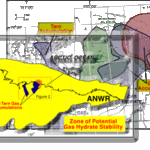Energy

Drilling is complete on an Alaskan North Slope well, cofunded by the Department of Energy, that could prove to be an important milestone in assessing America's largest potential fossil energy resource: gas hydrate.
Gas hydrate is an ice-like solid that results from the trapping of methane molecules - the main component of natural gas - within a lattice-like cage of water molecules. Dubbed the "ice that burns," this substance releases gaseous methane when it melts.
The size of the global gas hydrate resource is staggering, holding more ultimate energy potential than all other fossil fuels…

A Georgia Tech physics group has discovered how and why the electrical conductance of metal nanowires changes as their length varies. In a collaborative investigation performed by an experimental team and a theoretical physics team, the group discovered that measured fluctuations in the smallest nanowires’ conductance are caused by a pair of atoms, known as a dimer, shuttling back and forth between the bulk electrical leads. Determining the structural properties of nanowires is a big challenge facing the future construction of nanodevices and nanotechnology. The paper appears in the January…